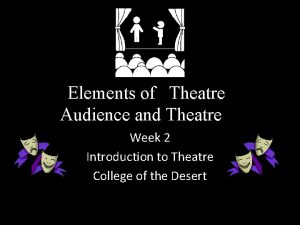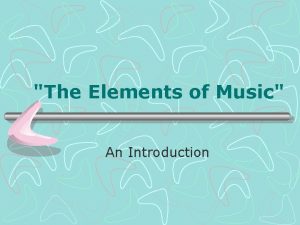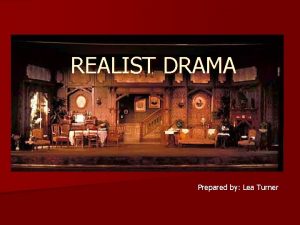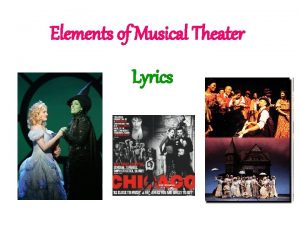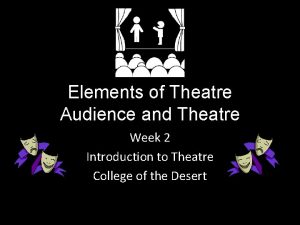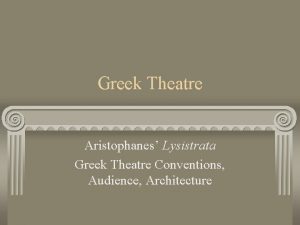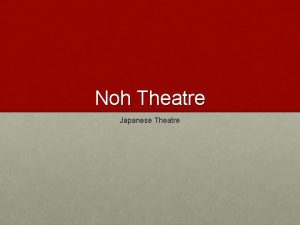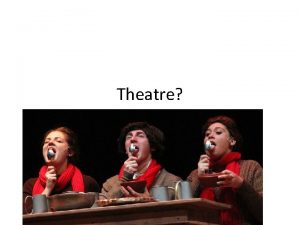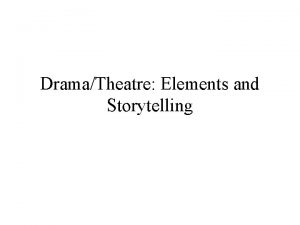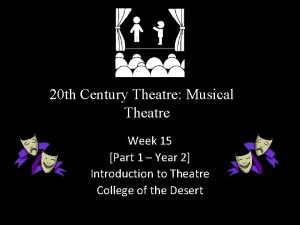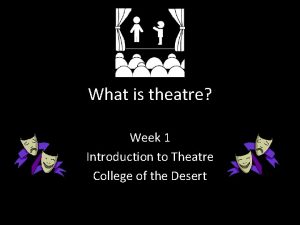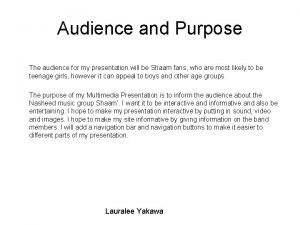Elements of Theatre Audience and Theatre Week 2





















- Slides: 21

Elements of Theatre Audience and Theatre Week 2 Introduction to Theatre College of the Desert

• • Special Qualities of Theatre is lifelike and familiar – it is an imitation of humans in action. Theatre is also exotic – characters are different from us. Verisimilitude – lifelikeness "Eros" – the fact that humans are before us on stage is inherently "erotic. " Fleeting – not recoverable – one performance cannot ever be like the rest. Objective: the audience gets only what the characters do or say – does not have vantage point of prose fiction, where the author can comment on action / characters. Complex: -- uses complex means – all art forms – to convey. Theatre is Immediate: happens to us now and never again the same way.

Special Qualities of Theatre Audience: • We bring our own experiences with us and help dictate the kinds of theatre done • We participate – our presence affects the event Performers: • Have different training, experiences, talents, perceptions, and imaginations What is performed: • Usually a script (play) – but not always written down • Improvisation -- “action “ embodied by performers and seen by audience • Simplified definition of a theatrical event: – • A does to B with C watching Structure of plays and acting styles will influence Performance: • All elements together – performers, sets, costumes, lights, makeup, sound, audience, what is performed, environment Environment: • • • Physical environment Social – can affect attitudes Can make a non-political play or non-socially-significant play political or significant

The Audience and the Theatre • The audience is most important – a group of individuals gathered together at a certain time and place for no purpose other than to see the performance (though some may be doing other things: placing bets, writing reviews, wasting time, etc. ) • Audience for a theatre performance has artistic self-awareness. • Audience for sports (spectators) – competition – outcome not predetermined (as it is with most theatre – though some plays have varied outcomes (Night of January 16 and The Mystery of Edwin Drood). • The audience gives its "permission" to the art. • A social phenomenon -- "conventions" -- "agreements" about what audiences will accept – how "story" will be told.

How does theatre appeal to audiences? 1. Sensory stimulation (light and sound): • Eros – the live performer a powerful appeal to our senses • Theatre critic Walter Kerr -- ("We are contenders, making the play and the evening and the emotion together. We are playmates, building a structure. ") • Theatron – seeing place – Greek • Auditorium – hearing place – Roman • Drama comes from the Greek verb "dran" – to do or to act = action • Vision is most powerful • Sound is another strong sense

How does theatre appeal to audiences? 2. Human values -- story and character inherent in the text of any play: • • Stories are compelling -- a framework for other values. Response comes from suspense, surprise, revelations, unfolding of events, reversals discoveries. Audience can anticipate if prepared for. Character -- the representation of a human being in a theatrical performance (or in the literary work) -- as much as the audience needs to know. . – – – We identify -- that character is like me. Subconscious references (like nightmares). Association -- historical people, people from our pasts. 3. Artistic excellence 4. Intellectual value • • The idea, or theme ("the me") usually takes care of itself, if presented well – becomes more acute over time Performance values must succeed to communicate idea All four of these work together. . . reading a play is only part of its potential.

How does theatre appeal to audiences? Audience sees: • • • Innovation Style Historical period Level of abstraction Social class Given circumstances A danger: • The "Affective fallacy" – responding to our own perceptions only – For instance, someone undergoing a divorce / separation might react to the play, Kramer versus Kramer in a different way from someone else; similarly, one who has had the experience of suicide in their lives might react quite differently to the play Ordinary People than someone else).

Realistic vs. Non-Realistic Elements Realistic Story Non-Realistic Story Events which the audience knows have happened or might happen in everyday life. Events which do not take place in real life but occur only in the imagination. For example: Blanche Du. Bois in the play, A Streetcar Named Desire, goes to New Orleans to visit her sister and brother-in-law. For example: Emily in Thornton Wilder’s Our Town, after she has died, appears alive and returns to visit the Earth for one day.

Realistic vs. Non-Realistic Elements Realistic Structure Non-Realistic Structure Action is confined to real places; time passes normally as it does in everyday life. Random use of time and place. For example: In the play ‘Night, Mother, the clock on the stage is the same time as it is in real life and plays out as such. For example: In August Strindberg’s The Dream Play, walls dissolve and characters are transformed, as in a dream.

Realistic vs. Non-Realistic Elements Realistic Characters Recognizable human beings – such as a family. For example: In Eugene O’Neil’s Long Day’s Journey into Night, there are clear characters in the play such as the mother, father, and two sons. Non-Realistic Characters Unreal figures like a ghost. For example: In William Shakespeare’s Hamlet, the character of Hamlet’s father is a ghost, or in his play Macbeth, the three witches are non-realistic characters.

Realistic vs. Non-Realistic Elements Realistic Acting Performers portray people as they behave in daily life. For example: The character of Nora Helmer in Henrik Ibsen’s A Doll’s House leaves her husband an unsatisfactory marriage in a believable, forthright manner. Non-Realistic Acting Performers enact ghosts and animals; they also engage in singing, dancing, acrobatics, and gymnastics in musical comedy or performance art. For example: Any Cirque du Soleil performance.

Realistic vs. Non-Realistic Elements Realistic Language Ordinary dialogue or conversation. For example: The gentleman caller in Tennessee Williams’ The Glass Menagerie tells Laura about his future in the language of an optimistic young salesman. Non-Realistic Language Poetry. For example: In most of William Shakespeare’s play, some see his language as poetry, or in the musical West Side Story, the song “Tonight” sung to Maria is seen as poetic.

Realistic vs. Non-Realistic Elements Realistic Scenery Rooms of a real house. For example: The play You Can’t Take It With You, uses a realistic set, and Chekhov’s play The Cherry Orchard uses a realistic set. Non-Realistic Scenery Abstract forms and shapes on a bare stage. For example: In most Greek plays such as Sophocles’ Electra.

Realistic vs. Non-Realistic Elements Realistic Lighting Lights onstage appears to come from natural sources – a lamp in the room or sunlight. For example: In Ibsen’s Ghosts, the sun is supposed to rise through the window and the lighting designer will try to accurately portray that. Non-Realistic Lighting Shafts of light fall at odd angles, also colors in light are used randomly. For example: A single blue spotlight used on a singer in a musical comedy.

Realistic vs. Non-Realistic Elements Realistic Costumes Ordinary street clothes. For example: All the characters in August Wilson’s play Fences wear everyday clothes from the 1950 s. Non-Realistic Costumes The bright costumes of a chorus in a musical comedy. For example: The strange costume that is usually worn by Caliban, the half-man, half beast in William Shakespeare’s play The Tempest.

Realistic vs. Non-Realistic Elements Realistic Makeup The natural look of characters in a domestic play. For example: All the characters in Lorraine Hansberry’s play A Raisin In the Sun. Non-Realistic Makeup Masks worn by characters. For example: Masks were used frequently in Greek tragedies.

Drawbacks Theatre is: • A minority art – Only one audience, a few people at a time, can see a performance. Compare that to a film showing in 3, 500 theatres. • An expensive art – There are weekly salaries and ongoing expenses. • An obscure art – There is less chance of fame for its artists.

The Basic Elements of Theatre • Script/Text, Scenario, Plan: – • The Process: – • This is the coordination of the creative efforts usually headed up in theatre by the director. It is the pure process by which the playwright’s work is brought to realization by the director, actors, designers, technicians, dancers, musicians, and any other collaborators that come together on the script, scenario, or plan. This is the works in progress stage. The Product: – • This is the starting point of theatrical performance. The element most often considered as the domain of the playwright in theatre. The playwright’s script is the text by which theatre is created. It can be simplistic, as in the 16 th century, with the scenarios used by the acting troupes of the Commedia dell’ arte, or it can be elaborate, such as the works of William Shakespeare. The script, scenario, or plan is what the director uses as a blue print to build a production from. This is the end result of the process of work involved. The final product that results from all of the labors coming together to complete the finished work of script, scenario, and plan, in union with all of the collaborators in the process to create the final product. This is what the audience will witness as they sit in theatre and view the work. The Audience: – Theatre requires an audience. For all of the arts public is essential. The physical presence of an audience can change a performance, inspire actors, and create expectations. Theatre is a living breathing art form. The presence of live actors on the stage in front of live audiences sets it apart from modern day films and television.

3 Reasons a Theater Degree Is Important According to Backstage. com, • Theater is a business – As Derrick Sanders, cofounder of Congo Square Theatre Company in Chicago, once said, “It should be called a Business Show because the Business comes first. ” Although people may pretend that professional theater is a bunch of people putting on a play just for fun, the reality is that virtually every production is an accurately planned and coordinated business activity. – Theater companies typically are not-for-profit or nonprofit entities with a board of directors and compensated employees, who appear both onstage and in the conference room. They feature marketing and public relations, education, and grant-writing departments (or people). – A theater degree prepares a person to enter the business of making art.

3 Reasons a Theater Degree Is Important According to Backstage. com, • The business of theater is good preparation for other careers. – Rahm Emanuel, the current mayor of Chicago and formerly Chief of Staff to President Obama as well as a Congressman, majored in the Humanities in college with a specialization in dance. “Value” studies would look at Emanuel and identify him as not being successful because he neither works as a professional dancer nor earns income in the field of dance. Instead of adopting this flawed logic, it is important for us to acknowledge that the skills gained through theater apply to other jobs and careers outside of the performing arts. – Theater majors frequently become makers and producers of theater but they also (and probably in equal or greater numbers) become lawyers, politicians, management consultants, marketing executives, and community educators to name just a few of the many career paths open to them.

3 Reasons a Theater Degree Is Important According to Backstage. com, • Social importance and salary do not always correlate. – According to Payscale. com, the majors with the least “salary potential” are Theology, Child and Family Services, Special Education, and Elementary Education. What unites these majors is their focus on the most vulnerable and sometimes the least fortunate members of society. To be clear, their real value to society far exceeds whatever number appears on a paycheck. – Theater serves a key function in our society. – The value of theater remains. It entertains. It educates. It creates community. It can take a significant amount of capital to create. It requires a lot of work to make. Artists labor to create art. That art may be ephemeral, a production that runs for only a hour or more, but the power of that creation is not only worthwhile but also invaluable.
 Invoked audience
Invoked audience Shakespeare audience summary
Shakespeare audience summary Week by week plans for documenting children's development
Week by week plans for documenting children's development Importance of audience in theatre
Importance of audience in theatre Dramatic literary elements
Dramatic literary elements Characters in drama
Characters in drama Forms of art
Forms of art 7 elements of music
7 elements of music Lea turner
Lea turner Lyric definition
Lyric definition Vcaa theatre studies study design
Vcaa theatre studies study design Oracle landed cost management
Oracle landed cost management Hydrosulfuric acid
Hydrosulfuric acid Http //elements.wlonk.com/elements table.htm
Http //elements.wlonk.com/elements table.htm What are the five elements of folktales
What are the five elements of folktales What are the features of african folktales?
What are the features of african folktales? Genre purpose and audience
Genre purpose and audience Audience of sample memorandum
Audience of sample memorandum Relationship between media and audience
Relationship between media and audience Rhetorical devices in learning to read and write
Rhetorical devices in learning to read and write Soapstone strategy
Soapstone strategy A company manufactures and sells x cellphones per week
A company manufactures and sells x cellphones per week



